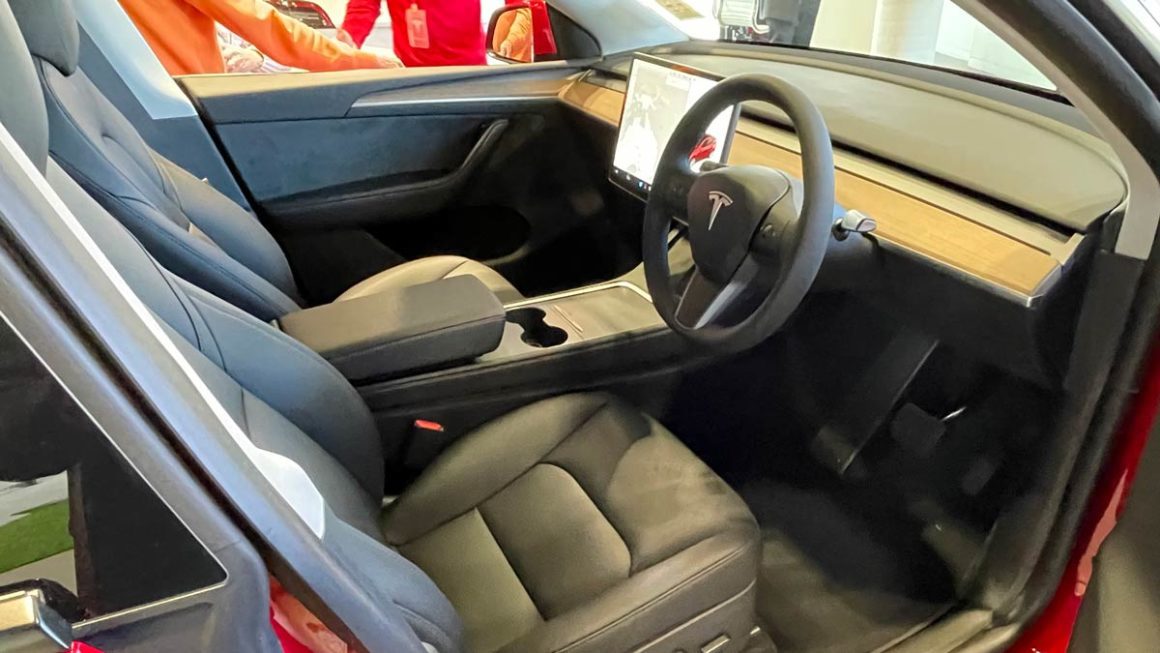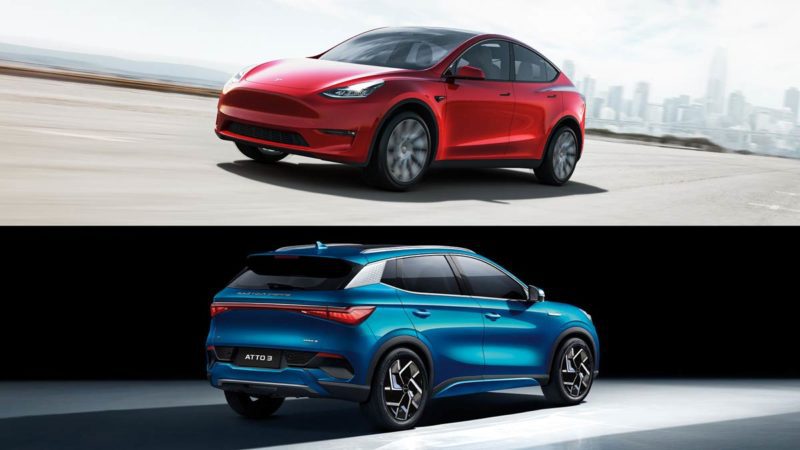Both the Tesla Model Y and the BYD Atto 3 have the potential to become best-selling EVs in Australia in 2022, alongside the already available Tesla Model 3.
Both are slated to arrive in Australia in the third quarter of 2022, and The Driven estimates thousands of orders have been taken for both from drivers.
In the case of the Model Y – Tesla’a popular electric crossover – there could already be a waiting list more than 12,000 strong (and word is from a reader that staff told him even just one of Tesla’s showrooms is consistently taking 50 orders a day).
The two make an interesting comparison – not least because one, The Model Y, is made by a now veteran player in the EV space, at least as far as Australia is concerned. Starting at $72,300 before on-roads for the base RWD variant, the Model Y is also available in a Performance variant from $96,700.
Whilst BYD is an automotive giant in China, the brand is very much unknown to Australian drivers.
And yet, drawn in on a combination of the lowest price for EVs currently on the market (it is available in a $44,381 Standard Range and $47,381 Extended Range – prices before on-roads) and some fairly impressive technology, it is estimated some 3,000-4,000 orders have been taken by import company EV Direct.
So what are the differences, and the similarities, between the two? With nearly $30,000 between the pricing of the two at the entry-level, do they even bear comparison? And which makes a better value proposition?
Tesla Model Y versus BYD Atto 3 specifications
The different pricing between the Model Y and Atto 3 reflects key specification differences including power, torque, acceleration, battery size, and driving range.
The Model Y has an extra 20kWh worth of battery under the floor than the Extended Range Atto 3, which of course explains some of the $46,000 price difference. This gives it 514km WLTP driving range, compared to the Extended Range Atto 3’s estimated 420km WLTP range.
But even though the Performance Model Y has less WLTP range than the Extended Range Atto 3, this is down to the fact the former has dual motors delivering 377kW power, 660Nm torque and acceleration from 0-100km/hr in just 3.7 seconds.
Putting that aside, the Model Y wins out on its base models also. It offers 70% more power even in the base RWD model, with 255kW compared to 150kW for both Atto 3 variants. This means acceleration is also faster by 0.4 seconds, thanks to 420Nm torque compared to the 310Nm of the Atto 3.
In terms of running costs, however, these specs also mean that the Performance Model Y will cost more per kilometre to run. That said, the RWD Model Y wins out on power costs as it is averaged at 139Wh/km compared to 144Wh/km for the Extended Range and 157Wh/km for the Standard Range Atto 3.
It’s probably also worth mentioning that both Atto 3 variants are front-wheel drive, which is great for drivers looking for better grippiness. However, both Model Y variants will win out on handling and towing (we’ll get to that later).
(There are some questions around driving range and energy efficiency for the Atto 3 also. Why is the Extended Range Atto 3, which has a larger battery and greater kerb weight, have more efficient energy usage?)
| Manufacturer | Tesla | Tesla | BYD | BYD |
| Model Name | Model Y | Model Y | Atto 3 | Atto 3 |
| Variant Name | RWD | Performance AWD | Standard Range |
Extended Range
|
| Price | $68,900 | $93,900 | $44,381 | $47,381 |
| Acceleration | 6.9 s | 3.7 s | 7.3 s | 7.3 s |
| Top Speed | 217 km/h | 241 km/h | No data | No data |
| Torque | 420 Nm | 660 Nm | 310 Nm | 310 Nm |
| Power | 255 kW | 377 kW | 150 kW | 150 kW |
| Efficiency | 139 Wh/km | 181 Wh/km | 156 Wh/km | 144 Wh/km |
| Range WLTP* (Comb) | 455 km | 514 km | 320 km |
420 km
|
| Battery Capacity | 62.3 kWh | 82 kWh | 52.5 kWh | 63.8 kWh |
| Battery Useable | 60 kWh | 76 kWh | 49.92 kWh | 60.48 kWh |
* WLTP range is estimated for the Atto 3
Tesla Model Y versus BYD Atto 3 dimensions and space
In line with its smaller price, the BYD Atto 3 is also a smaller car. It is just 4,455mm long compared to the 4,751mm Model Y – a difference of 296mm. It is also slightly narrower by 46mm (1,875mm compared to 1,921), and minimally shorter by 9mm (1,615mm compared to 1,623mm).
Interestingly though, it sits higher off the ground than the Model Y, with 175mm ground clearance according to the maker’s specs, compared to 167mm of the Model Y . This actually means it sits higher than the Volvo XC40 Recharge, making it the EV with the greatest ground clearance in Australia to date when it arrives.
In terms of cargo space, the Model Y wins hands down thanks to the greater length. It has double the cargo space with the back seats up than the Atto 3 (853 litres compared to 434 litres). With the back seats down (and they lay down flat), it offers a full 2 metres length in the back, and 1,925 litres of cargo capacity.

The Atto 3 by comparison offers 1,340 litres, which is still quite good given the length of the vehicle.
The Model Y also has a 117 litre “frunk” (front storage area under the bonnet). It’s not clear if there will be a frunk in the Atto 3 – as this video shows, there is room for one but the prototype seen in the Sydney showroom earlier in 2022 did not have one.
Tesla Model Y versus BYD Atto 3 interior and connectivity
Both the Model Y and Atto 3 rely largely on a central touchscreen to access vehicle controls, but one could hardly call the interior of the Atto 3 “minimalist”. It also has a central gear control in the centre console, whereas the Model Y uses the right gearstick on the steering wheel to control forward and reverse functions.
Notably, the Atto 3 has a turning touchscreen, allowing drivers to choose a landscape or portrait orientation. The touchscreen of the Model Y by contrast is fixed.

The interior styling of the two is also vastly different. Available in just one two-tone colourway, the Atto 3 features blue and white synthetic leather seats and upholstery and a white ribbed dash which sweeps around to the doors.
The Model Y comes with two interior options: black or white. The black comes with a real wooden accent of the dash, which is changed out for white in the optional $1,500 premium white option.

Connectivity differs somewhat also. While Tesla famously has refused to partner with major smartphone makers on connectivity, BYD is promising Android Auto and Apple CarPlay from Q4, 2022.
It also offers both USB-C and USB-A ports (one of each on the centre console and one of each in the rear), whereas the Model Y only offers USB-C ports in the centre console storage areas and on the back for rear passengers.
Tesla Model Y versus BYD Atto 3 exterior and wheels
Exterior colours are quite similar, though with some key differences. Both the Model Y and Atto 3 are available in White, Grey and Blue (the latter two costing $700 extra for the Atto 3, and $1,500 for the Model Y).
Both have a red option, but this is only available for the Extended Range Atto 3 and costs $700, whereas it costs $2,900 for the Model Y and is available on all models. White is standard for both, and the Model Y also has a black option for $1,500.
The Atto 3 comes with 18″ alloys as standard and there are no upgrade options. The Model Y comes with 19″ Geminis as standard, although these have not been welcomed with compliments. There is a 20″ Induction upgrade available for $2,900.
Tesla Model Y versus BYD Atto 3 vehicle-to-load
OK – there is absolutely no contest here. Tesla does not offer any form of bidirectional charging, and despite rumours a few years ago that it might go down that road, Elon Musk in 2020 said he believes it “has lower utility than you think.”
Nevertheless, it is something that some drivers want in an EV, as drivers start to think about cars as more than just something to get you from A to B.
The Atto 3 does offer vehicle-to-load, even though it strangely calls this VTOL instead of V2L, confusing some as this also stands for “vertical take off and landing” drones. This will be provided in the form of a portable adapter that allows the car to operate as a mobile power supply.
Tesla Model Y versus BYD Atto 3 charging
Without a doubt, the Tesla Model Y will offer a faster (and for the moment, more reliable) charging experience. Its top DC charging speed is 210kW compared to the Atto 3’s 80kW, and it also offers faster AC charging (11kW compared to 7kW).
The Model Y will of course also be able to use both the Tesla Supercharger network, as well as third-party public DC fast-chargers.
Tesla Model Y versus BYD Atto 3 extras
Some other features of both vehicles that bear considering include the fact that the Model Y has both front and rear heated seats, while the Atto 3 does not according to its spec sheet.
Both have electronic tailgates, and a slew of safety features including adaptive cruise control, auto emergency braking, collision warnings, rear cross traffic alerts and lane departure and keeping assist (although we are yet to try the Atto 3’s lane-keeping feature, we are expecting it to be more of an “assist” function compared to Tesla’s auto-steering function).
The Model Y also has Sentry Mode. The BYD Atto 3 says it has a ” digital video recorder” – stay tuned on what that means when test drives commence in July.

Both can also tow, however the Model Y wins out by far here. It is rated to tow 1,600kg braked and 750kg unbraked, whereas tow capacity for the Atto 3 is yet to be confirmed. Word is that it could be 750kg unbraked, and that EV Direct is working with local suppliers for tow hitch availability.
Tesla Model Y versus BYD Atto 3 servicing and warranty
Tesla allows drivers to book service appointments through its smartphone app. While it is unclear on what kind of app BYD will offer with the Atto 3, EV Direct has cut a deal with mycar to provide service.
The Atto 3 comes with a seven year battery and vehicle warranty, while the Model Y comes with 8 years or 160,000 km warranty for the RWD variant, and an 8 years or 192,000 km warranty for the Performance variant.
Neither yet have official safety ratings from ANCAP.
Final thoughts
When it comes down to it, the two vehicles are incredibly different on performance, range, features and of course price. Yet, they both offer compelling options to the limited EV market in Australia.
A known player on the EV market, with a wider choice of charging, more space and performance, but for a much dearer price. Or, a newcomer with solid EV credentials and a promise of high quality at a far more affordable price point. And that elusive V2L.
As mentioned above, test drives for the Atto 3 are expected to start next month. It may be a miss on EV Direct’s part that it didn’t arrange for vehicles to be available when it opened its order books in February, but the proof will be in the pudding as they say, when this becomes possible.
Tesla has already started test drives for customers of the Model Y – see this customer review here, and The Driven editor Giles Parkinsons’ review here.
| Manufacturer | Tesla | Tesla | BYD | BYD |
| Model Name | Model Y | Model Y | Atto 3 | Atto 3 |
| Variant Name | RWD | Performance AWD | Standard Range | Extended Range |
| ANCAP | – | – | N/A | N/A |
| Price | $68,900 | $93,900 | $44,381 | $47,381 |
| Country of manufacture | China | China | July 2022 | July 2022 |
| Acceleration | 6.9 s | 3.7 s | 7.3 s | 7.3 s |
| Top Speed | 217 km/h | 241 km/h | No data | No data |
| Torque | 420 Nm | 660 Nm | 310 Nm | 310 Nm |
| Power | 255 kW | 377 kW | 150 kW | 150 kW |
| Drive Type | Rear | AWD | Front | Front |
| Efficiency | 139 Wh/km | 181 Wh/km | 157 Wh/km | 144 Wh/km |
| Battery Capacity | 62.3 kWh | 82 kWh | 52.5 kWh | 63.8 kWh |
| Battery Useable | 60 kWh | 76 kWh | 50.1 kWh | 59.5 kWh |
| Charge Port Location(AC) | Left Side-Rear | Left Side-Rear | Right Side – Front | Right Side – Front |
| Charge Rate (DC) | 210kW | 210kW | 80kW | 80kW |
| Charge Rate (AC) | 11kW AC | 11kW AC | 7kW AC | 7kW AC |
| Charge Time (AC) | 6 hr 2 min | 7 hr 45 min | 7 hrs 10 min | 8 hrs 30 min |
| FCP Location (DC) | Left Side – Rear | Left Side – Rear | Right Side – Front | Right Side – Front |
| Range WLTP (Comb) | 455 km | 514 km | 320 km | 420 km |
| Energy WLTP (Comb) | 167 Wh/km | 181 Wh/km | 125 Wh/km | 126 Wh/km |
| Seats | 5 | 5 | 5 | 5 |
| Body Style | SUV | SUV | SUV | SUV |
| Tow Rating | 1600 kg | 1600 kg | 750 kg | 750 kg |
| Tow Hitch Avaliability | Yes | Yes | No Data | No Data |
| Frunk Capacity | 117 L | 117 L | No Data | No Data |
| Cargo Capacity | 853 L | 853 L | 434 L | 434 L |
| Max Cargo Capacity | 1925 L | 1925 L | 1340 L | 1340 L |
| Wheel Base | 2890 mm | 2890 mm | 2720 mm | 2720 mm |
| Curb Weight | 2003 kg | 2072 kg | 1680 kg | 1750 kg |
| Dimensions | 4751x1624x1921 mm | 4751x1624x1921 mm | 4455x1615x1875 mm | 4455 x 1615 x 1875 mm |
| V2L | No | No | Yes | Yes |
| EV Dedicated Platform | Yes | Yes | Yes | Yes |
| Ground Clearance | 167mm | 167mm | 175mm | 175mm |
| Turning Circle | 12.1 m | 12.1 m | No Data | No Data |
| Sunroof | Yes | Yes | Yes | Yes |
| Roof Load | 75 kg | 75 kg | No Data | No Data |
| Roof Rails | No Data | No Data | Yes | Yes |

Bridie Schmidt is associate editor for The Driven, sister site of Renew Economy. She has been writing about electric vehicles since 2018, and has a keen interest in the role that zero-emissions transport has to play in sustainability. She has participated in podcasts such as Download This Show with Marc Fennell and Shirtloads of Science with Karl Kruszelnicki and is co-organiser of the Northern Rivers Electric Vehicle Forum. Bridie also owns a Tesla Model Y and has it available for hire on evee.com.au.




